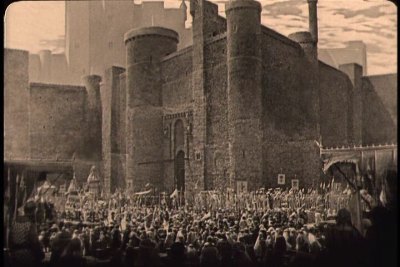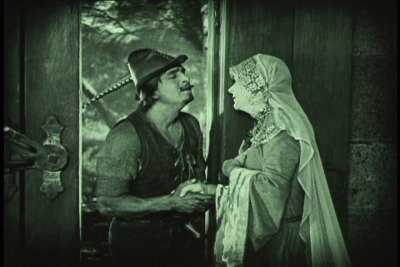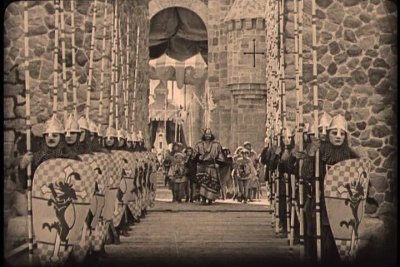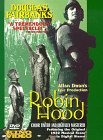| Reviews & Columns |
|
Reviews DVD TV on DVD Blu-ray 4K UHD International DVDs In Theaters Reviews by Studio Video Games Features Collector Series DVDs Easter Egg Database Interviews DVD Talk Radio Feature Articles Columns Anime Talk DVD Savant Horror DVDs The M.O.D. Squad Art House HD Talk Silent DVD
|
DVD Talk Forum |
|
|
| Resources |
|
DVD Price Search Customer Service #'s RCE Info Links |
|
Columns
|
|
|
Robin Hood (1922)
The Movie:
 The Douglas Fairbanks movie for 1922 was his telling of the Robin Hood legend. He had been fascinated by the story since boyhood, but was never convinced that it would make a good picture. After The Three Musketeers was such a huge success, he realized that costume action films were what he was best suited for in the eyes of the public, and was looking around for another such project. When the concept of Robin Hood was brought up, he initially rejected it, but then realized that it would be the prefect vehicle. There would be a lot of stunts, a romantic interest, fights and jousts, and it would include the themes of fairness and chivalry that his other films promoted.
The Douglas Fairbanks movie for 1922 was his telling of the Robin Hood legend. He had been fascinated by the story since boyhood, but was never convinced that it would make a good picture. After The Three Musketeers was such a huge success, he realized that costume action films were what he was best suited for in the eyes of the public, and was looking around for another such project. When the concept of Robin Hood was brought up, he initially rejected it, but then realized that it would be the prefect vehicle. There would be a lot of stunts, a romantic interest, fights and jousts, and it would include the themes of fairness and chivalry that his other films promoted.
To make this picture, Fairbanks and his team did a huge amount of research. They studied the legend itself, but also the clothes and amour, how people lived, how they cooked and what they ate. They accumulated a library's worth of books and documents for the project.
There was a problem though. Fairbanks wanted to spend a million dollars on the production, and the industry was in a slump. Money was hard to come by so he financed the entire picture out of his own pocket, and was the sole owner of the film.
Fairbanks commissioned the biggest set ever built in Hollywood for a silent film. The castle that was constructed covered ten acres. It was ninety feet tall, and historically accurate in every detail. Fairbanks gave the go ahead to start on the set before he left for New York on some business. As soon as he stepped off the train upon his return, he asked about the castle. It was finished, and he sped off to see it. Fairbanks toured the set for hours, inspecting every detail. At the end of his inspection, he announced that the film would not be made! The set was just too grand, to eye catching. He was an intimate actor, and would be lost on such a stunning set, he just wouldn't be able to compete. So the picture was cancelled.
Director Alan Dwan is responsible for changing Fairbanks mind. Dwan convinced Fairbanks to come back to the set. The director pitched a scenario for the movie: Robin Hood is fighting a large group of knights. He starts getting overwhelmed, so he runs up the stairs to a walkway overlooking the main hall. But more knights enter from the other end, cutting off his retreat. Robin Hood jumps up on the balustrade fighting them, but there is no hope. Dwan stopped talking. "Yeah, then what do I do?" Fairbanks asked. Dwan climbed up onto the balustrade and jumped onto a curtain that was hanging next to it. Underneath was a slide. He slide all the way to the floor fourth feet below, then ran out the giant door to freedom. "I'll do it!" Fairbanks yelled down.
The castle was the talk of Hollywood. One day Charlie Chaplin asked Fairbanks if he could borrow it for a scene in a film. When Fairbanks wondered what he wanted it for, Chaplin showed him the gag he concocted: The large drawbridge lowered. Chaplin walks out the a cat under his arm. He lets the cat out, picks up a quart of milk and the newspaper, and walks back in as the drawbridge slowly closes. Though Fairbanks loved the gag, he didn't want his castle to be used in a comedy.
 After spending so much time and money on the production, Fairbanks was worried, rightly so, that a poverty row film studio would rush another version into production and release it just before his, to capitalize on the press that his movie was getting. After all, the story was in the public domain. To help minimize the chances of that happening, he officially entitled his movie "Douglas Fairbanks' Robin Hood."
After spending so much time and money on the production, Fairbanks was worried, rightly so, that a poverty row film studio would rush another version into production and release it just before his, to capitalize on the press that his movie was getting. After all, the story was in the public domain. To help minimize the chances of that happening, he officially entitled his movie "Douglas Fairbanks' Robin Hood."
Like most of Fairbanks costume movies, the story of Robin Hood is well known today. The Earl of Huntingdon (Douglas Fairbanks) is off on a Crusade with Richard the Lion-hearted (Wallace Beery.) Having beaten Sir Guy of Gisbourne (Paul Dickey) in a joust (although Sir Guy tried to cheat) the King has assigned Huntingdon as his second in command, much to the distain of Sir Guy.
With Richard gone, his brother Prince John (Sam De Grasse) is left in charge. John quickly puts his corrupt cronies into positions of power and turn the idyllic England into a cruel and brutal place.
On his way to the Holy Land, Huntingdon receives word of Prince John's deeds. Before he can inform the King, he gets framed for desertion. Managing to escpape with the help of his squire, Little John (Alan Hale Sr.,) the Earl returns to England to protect the people until its rightful sovereign can return. Still a wanted man, he takes on the persona of Robin Hood, and forges the petty thieves and outcasts of Sherwood forest into a fighting force.
Robin Hood ended up costing $1.4 million. A huge sum in those days, twice as expensive as D. W. Griffith's lush Intolerance. The risk was well worth it though, Robin Hood ended up making $2.5 million dollars and it received the Photoplay Medal of Honor for 1922.
How does the film stand up today? Very well, for the most part. It seems a little long winded at the beginning. The first half sets up the whole story, and it is an hour into the movie before Robin Hood makes his first appearance. After that things move quickly. Robin and his men keep the Sheriff of Nottingham running in circles. There are many fun stunts, including the one that convinced Fairbanks to make the movie, of course.
As far as the acting goes, this was an excellently cast film. Sam De Grasse was a wonderfully villainous Prince John, but Wallace Beery was the best supporting actor playing the noble King Richard. Fairbanks shines as always. is taunting of the knights that are chasing him and carefree demeanor add a lot of humor to the film. Thought his gestures are broad and dated by today's standards, they don't appear farcical.
The direction is a tad slow in the first half, but the action scenes are shot well, and the editing is very good. There is just the right amount of tension and suspense (though you never really think that Robin will be captured or hurt.) Like the other Fairbanks movies, a very enjoyable film.
The DVD:
Audio:
The musical accompaniment for Robin Hood is the original 1992 score preformed by Eric Behelm. While the sound quality itself is very good, something has to be said about the quality of the score itself. It is preformed on a synthesizer, and is totally inappropriate for this movie. A piano score would have suited this film much better. The electronic slightly tinny sounding synthesizer just ruins the mood of the film for me. I can't imagine why Kino opted for the soundtrack. Surely a piano score would not have cost any more. One of Fairbanks biggest movies really deserves a full orchestra, but barring that a three piece ensemble would have sounded very good. It is a shame that this disc is flawed with inappropriate music.
 Video:
Video:
This print comes from a 35mm negative, with tinting added, and projected at "the correct projection speed." I wish they would have stated what at speed they did project it. The 133 minute speed is longer than the previous Kino release of 120 minutes, that seems to imply they either included extra footage, or ran it at a slower speed. There really wasn't a set speed for all movies in this period, but most the "silent speed" of 16 fpm is really too slow for this film. It was originally intended to run at 22fps according to at least one source. In any case, the speed looked good. The picture wasn't jerky and the movement didn't look unnatural. While not a perfect print, it is very good. There dust and scratches are minimal, and the print has a full range of tones. The huge castle set comes through in fine detail, and only a little grain. A very good presentation of a classic movie.
The Extras:
This disc has a couple of fun extras. First there are three minutes of outtakes. Most of these are alternate takes, rather than goofs or major blunders. It was interesting to see.
The other bonus is an except from a Will Rogers short, Big Moments from Little Pictures. While I would have much appreciated the full film, which appears on the Slapstick Encyclopedia boxed set, this 6 minute except is great to have. Rogers parodies Robin Hood and Fairbanks. His Robin is very foppish and carefree, as are the Merry Men. A cute send up.
Final Thoughts:
This movie was believed lost for many years. As the stories about the sets and the production values circulated, the yearning to see the movie grew. Luckily, a copy turned up in the late 50's, but it was still rarely seen, and when it was shown, it filled theaters once again. Not only can you see a very good copy of this film, but you can have a DVD of this classic for your very own. This Kino disc, even with the less than ideal synthesizer accompaniment, is a great disc. Highly Recommended.
|
| Popular Reviews |
| Sponsored Links |
|
|
| Sponsored Links |
|
|
| Release List | Reviews | Shop | Newsletter | Forum | DVD Giveaways | Blu-Ray | Advertise |
|
Copyright 2024 DVDTalk.com All Rights Reserved. Legal Info, Privacy Policy, Terms of Use,
Manage Preferences,
Your Privacy Choices | |||||||














